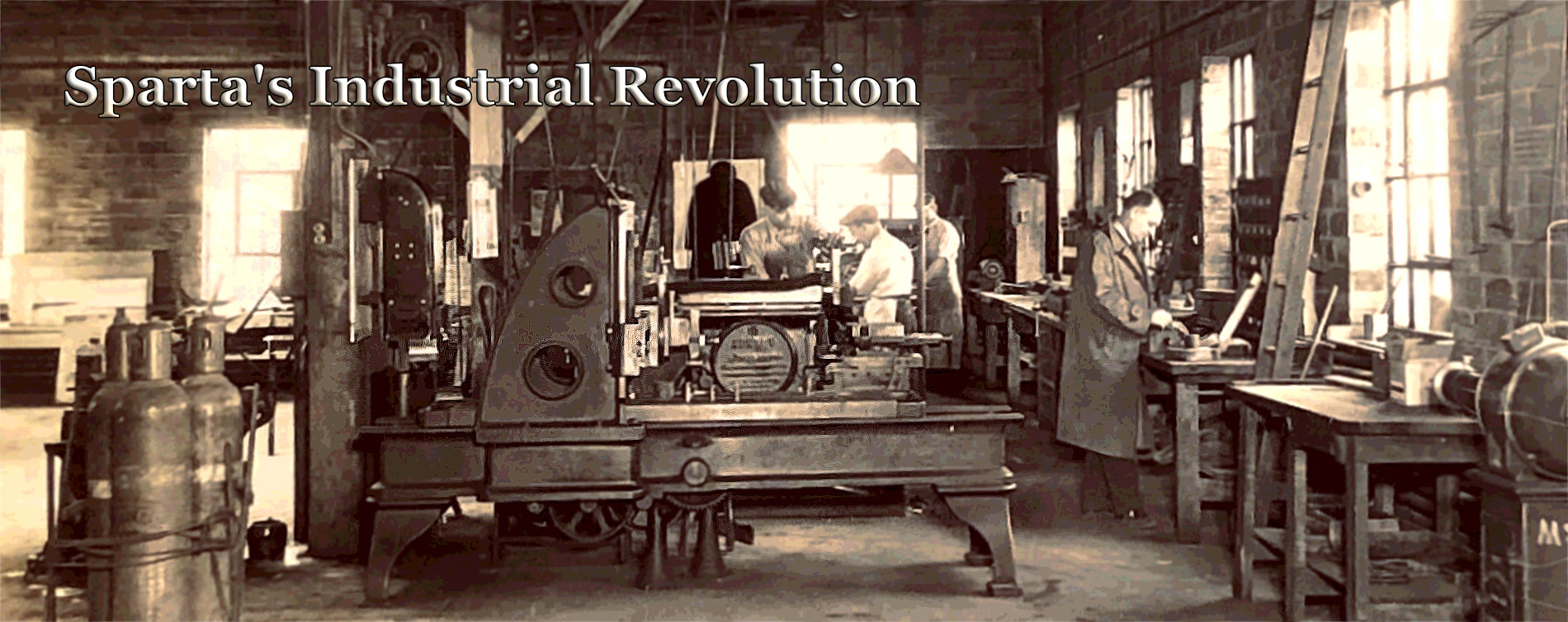

Innovation,
Quality & Style
As the railroad connected Sparta to the rest of the world, soon an industrial boom was ignited. The prospect of shipping materials in and finished products out while situated in a relatively close proximity to the Grand Rapids metropolitan area made Sparta a very attractive prospect for factories. With a ready and willing workforce, skilled tradesmen, as well as individuals possessing ingenuity, determination, and a good measure of courage, the future was promising. And so, the Industrial Revolution dawned bright for the fair village.
Welch Folding
Bed Company
Phenomenal success smiled upon Lyman W. Welch's business right from the get-go after opening the doors of his Sparta factory. In the History of Grand Rapids Michigan by Albert Baxter published in 1891, the Welch Folding Bed Company was said to be "...perhaps the largest, if not the only, manufactory in the United States whose product is exclusively folding beds. The company was organized December 6, 1886, as a copartnership between L.W. Welch and W.S. Earle."
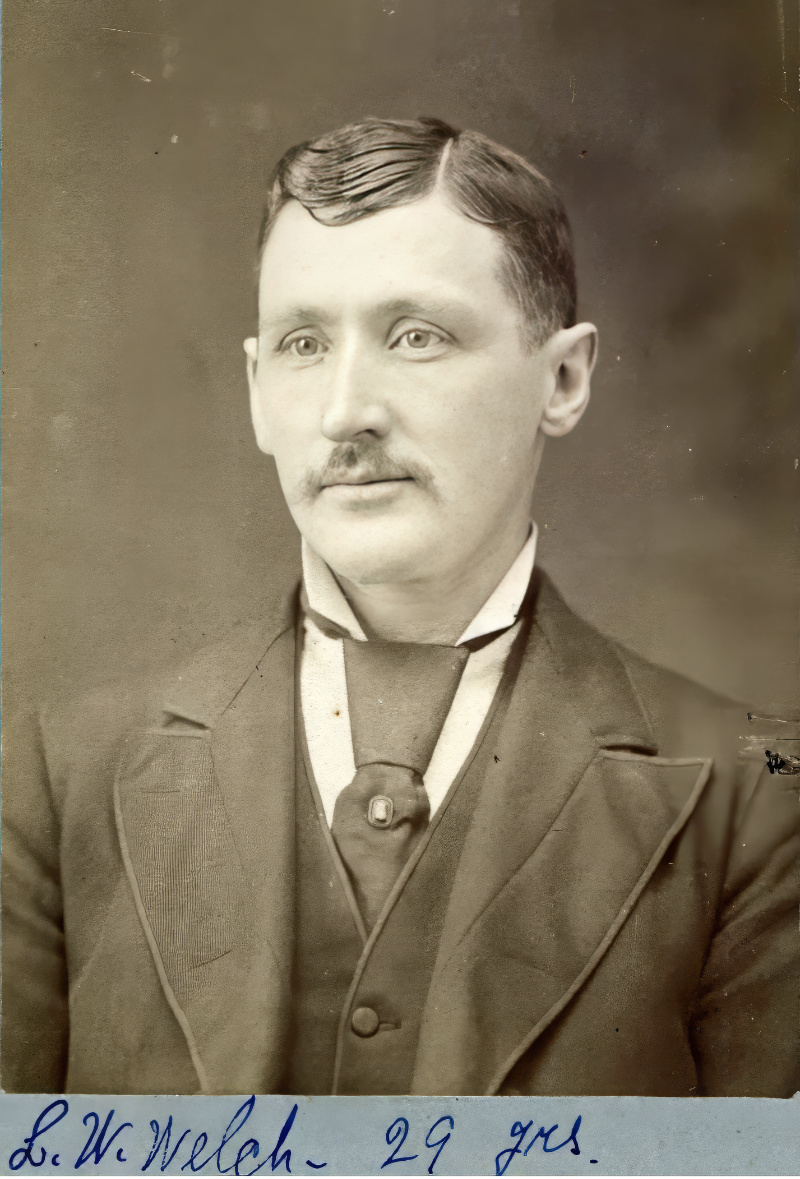
Young businessman, Lyman W. Welch--courtesy of great-grandson Warren Welch
Lyman Wesley Welch
From humble beginnings, he was "a Randolph boy who, starting without a dollar in the world, has by his own integrity, ability and industry won for himself a place among the largest and most successful manufacturers of the country," the local Vermont newspaper, Herald and News, described and celebrated Lyman's success.
His story began as the firstborn son of a miller, when he was welcomed into the family of Joseph & Lavina C. (Pollard) Welch in September 1850 at Lyme in Grafton county New Hampshire. Raised with the blessings of a simple life on the family farm, the young man developed an interest which blossomed into a passion for furnituremaking. As a boy, he bound and transported furniture turnings and spindles to market. When he came of age, Lyman struck out on his own and learned the retail home furnishings trade at Randolph, employed by Whitcomb E. Lamson.
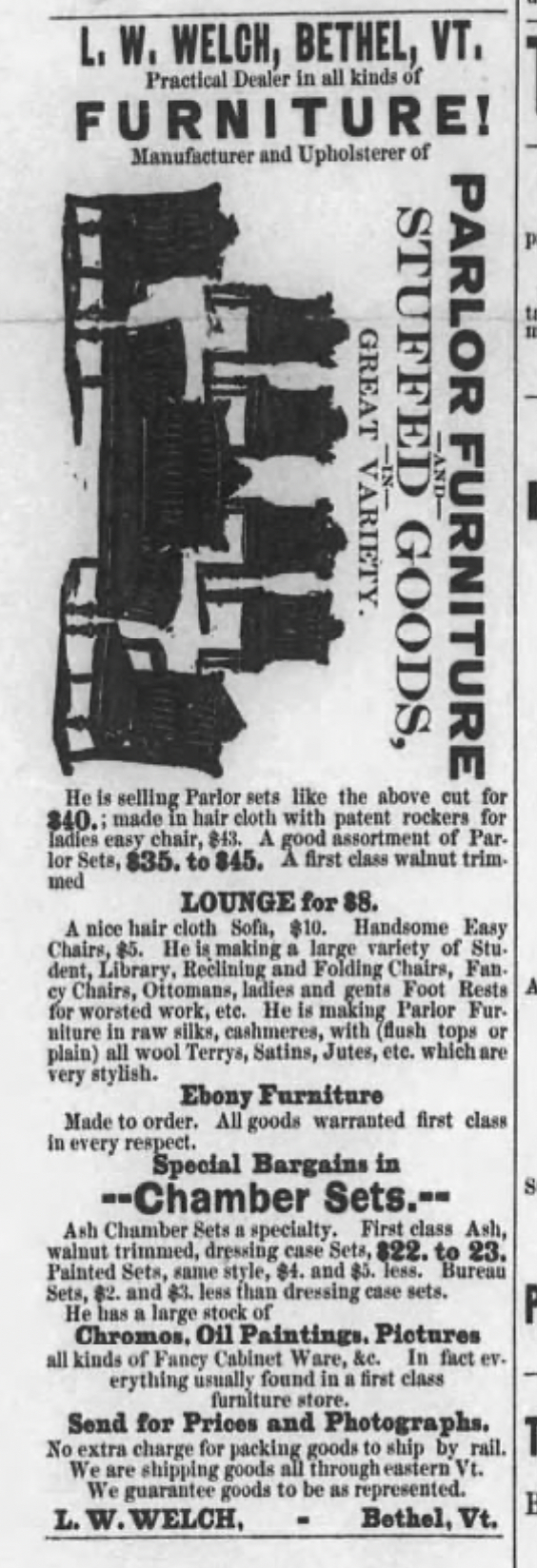
Early ad for Lyman's business--The Vermont Farmer (12 Dec 1879)
At twenty-seven, Lyman, widely known as "the furniture man", suffered the loss of his newly opened furniture store when a massive fire swept through the town of Bethel, Vermont, as reported December 13, 1877. But he did not let that deter him. He remained at Bethel, rebuilt his business, and became well respected as a manufacturer and upholsterer of quality parlor furniture and chamber sets sold at a fair price.
Lyman exhibited furniture of his own design and manufacture at the state fair where he garnered praise and the next year, 1880, was awarded the gold medal. Shortly thereafter, the Vermont Journal reported L.W. Welch "has been contracted to build a new courthouse at Montpelier with its furniture." His craftsmanship well received, Lyman relocated his business into an old button factory at Montpelier where it did exceedingly well.
Boyington's automatic folding beds were promoted and sold at his Montpelier salesroom by 1882 and he experimented with other styles of beds with space saving features. Lyman's first commercial effort in the design and manufacture of his new invention was the Welch Portiere Upright Folding Bed. It folded up against a wall and was hidden from view by draperies when not in use. He moved to a larger facility. A few months later, he improved his "...patented Portier beds, which makes it possible to have an entire chamber set, except the chairs, in one piece, and that occupying a trifle more space than a dressing case." Montpelier Vermont's Argus and Patriot describe it's function, "The dressing case, mirror, commode and small closet are in front, and upon turning it around a bed is found swung up against the back." To raise capital in August 1885, Lyman sold the exclusive right to manufacture and sell his patented combination folding bed in limited parts of New York state to James P. Hayes.
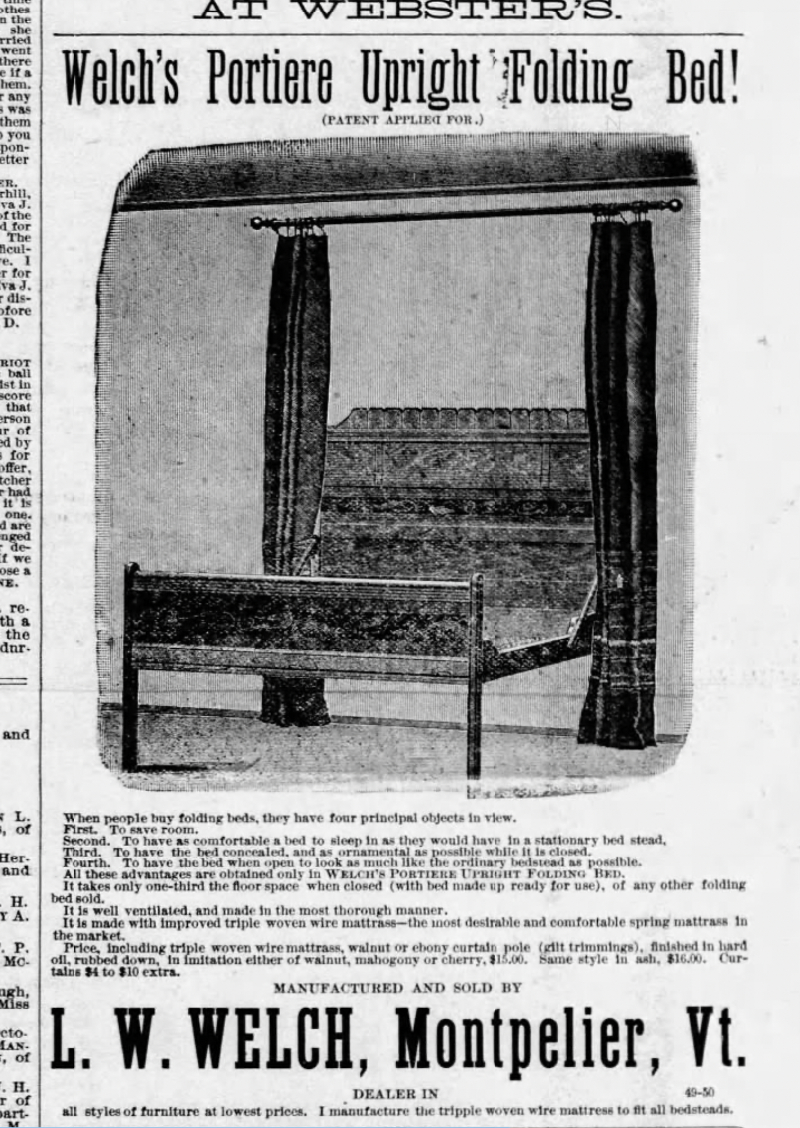
Welch's patented Portier bed--The Argus and Patriot (5 Nov 1884)
Consideration of a location for the construction of a new factory and show room, the allure of becoming part of the famed "furniture city"--Grand Rapids, Michigan--tipped the scale. He made contacts and arrangements to relocate to Grand Rapids then in March 1886, he "sold his furniture store stock to concentrate on the folding bed business."--The Vermont Watchman.
Before coming to Kent county, Michigan, Lyman "was engaged in the business of retailing furniture in one of the cities of New England. When the use of folding beds became general, Mr. Welch made a study of their construction, and possessing much native ingenuity proceeded to employ his faculties in the invention of a combination folding bed," Dwight Goss wrote in his 1906 History of Grand Rapids Industries. "The merits of his invention were quickly recognized when Mr. Welch came to Grand Rapids and perfected arrangements for the manufacture of the bed. Local capital recognized the value of the patent and a firm was organized to purchase a factory at Sparta, Mich., where the manufacture of beds were undertaken. The merits of the Welch bed received instant recognition in the leading markets of the United States and the demand became so great that several enlargements of the factory, from time to time, became necessary."
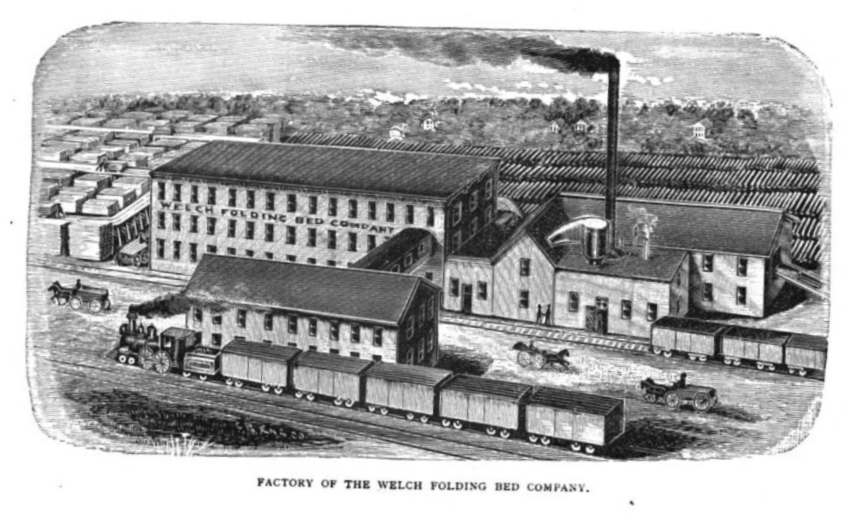
Welch Folding Bed Company's original Sparta plant--The City of Grand Rapids Manufacturing Advantages Commercial Importance by Robert H. Baker (1889)
The original Sparta plant Mr. Welch purchased had previously been used a short time for furniture making, but was destined to become "...the largest folding bed factory in the world, with a worldwide market."--"Old Bed Plant to Be Razed" in The Grand Rapids Press (14 Jul 1936)
A State of Michigan Bureau of Labor and Industrial Statistics report from 1890 for the company declared the "total wholesale value of goods manufactured during the past fiscal year (was) $90,000. Number of employees, 100. Total amount of wages paid... $25,000. ...All work 10 hours, are paid weekly and in cash." That $90,000 in sales is worth $2.9 million today.
With so much lumber on site, fire was an ever present concern. On the 19th of November in 1889, the company suffered a $10,000 loss in a blaze, as reported in The Standard Weekly Insurance News. The Worden & Van Winkle grain elevator across the street was not as fortunate and was destroyed in the fire. Welch's loss was limited to one warehouse that was insured. There was fear the fire might sweep the village and a Grand Rapids fire engine was loaded onto a special train to assist, but fortunately winds were favorable and the fire was controlled before the train left the station.
The new enterprise's first expansion would address fire mitigation as it was ready for operation by December of 1890 as described by The Grand Rapids Press in:
- "IT IS SPARTA'S PRIDE.--
Completion of the Welch Folding Bed Company's New Factory Building.--
Pleasant Social Exercises Saturday Evening Formally Opening the Big Establishment.--
There was a carload of jolly people went up to Sparta Saturday evening upon invitation of Messrs. Welch & Earle to be present at the dedication of the large addition to the Welch Folding Bed company's plant. Upon the arrival of the train at Sparta the local band was there to receive the visitors from Grand Rapids and escort them to the factory. Upon the second floor of the large building, the good people of Sparta and vicinity, to the number of nearly one thousand, had assembled, to lend their presence and greeting, and to rejoice over the completion of an enterprise freighted with so much importance to the pretty little village in northern Kent. The big factory was handsomely illuminated with electric lights furnished by the company's own plant, and presented a most cheerful appearance."
"Hon. A.B. Cheney called the assembly to order and from a platform erected for the musicians, introduced the Rev. J.H. Maynard, who proved himself to be a very happy talker. He felt a special pleasure at being present for it was his sixtieth birthday, and this coupled with the fact that he was rejoicing with others in the establishment of a great interest for Sparta, made the occasion one of double interest to him. He complimented the inventive genius of Mr. Welch and praised the energy displayed by Mr. W.S. Earle, in building up a great industry. The reverend gentleman closed his remarks by declaring the union of the village of Sparta with the Welch Folding bed company sealed, and that which he had bound together "let no man put asunder." After the speaking there was a grand march participated in by about 700 persons and led by Mr. Roger Griswold and Miss Fannie Earle. Dancing was continued until midnight and all had a merry good time and all wished the Welch Folding Bed company unlimited success. During the evening a collation of sandwiches, coffee and doughnuts was served and the great gathering was fed to its entire satisfaction."
"The Welch bed has become one of the great furniture industries of the country and its value is known and appreciated wherever it is sold. In fact it is doubtful if any one article of furniture that is made, is better known to the trade than is the Welch bed. Its many designs in combination and finish makes it a highly ornamental article as well as a useful one. The company has built up a surprisingly large trade and the new building dedicated Saturday night was an addition to their old plant, made necessary by their increased and constantly growing business. The old factory is 150x60 three stories high, and the new building is 150x50, with an annex 32 feet square. The factory is provided with a new boiler and engine room equipped with two boilers and a Lansing engine of 150 horse power, the old 50 horse power engine having been transferred to the sawmill which stands detached from the main building. In addition the company have built one of the largest dry kilns in the state, having a capacity of 75,000 feet of lumber. Every precaution has been used against fire, the buildings all being fitted with automatic sprinklers throughout, which are supplied by an immense tank of water on the roof on the main building. Several hundred feet of hose have been added as an extra precaution, water for this purpose being pumped from a reservoir holding 500 barrels, which has been built a short distance from the factory. The buildings afford a floor space of 50,000 square feet, are are admirably arranged for their purpose. All in all, it is a complete factory, with a capacity of from ten to twelve thousand beds a year. Spartans may take a just and pardonable pride in claiming it as a banner industry, while the company itself is entitled to hearty congratulations upon its past success and its bright promises for the future."
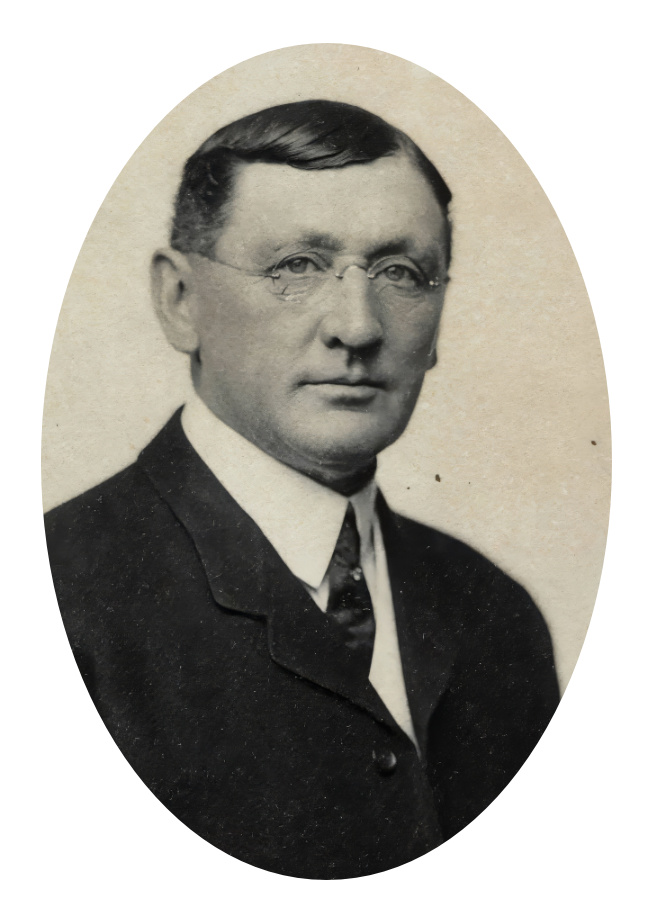
Lyman W. Welch during his 40s--courtesy of great-grandson Warren Welch
Albert Baxter's 1891 book continued: "The salesroom and main offices are at Grand Rapids, but the factory proper is at Sparta, Kent county, and, with shipping warehouse, covers 45,000 square feet of floor space, with lumber yards of about ten acres adjoining, giving employment to 100 hands, whose earnings place about $4,000 per month in circulation. Their product, consisting of the Welch patent folding bed (combining six articles of furniture in one), amounts to about $150,000 annually, with an investment of $70,000 capital." For a fledgling business to establish and increase sales figures so swiftly is quite amazing. In today's dollars, their annual $150,000 sales translates to an impressive $5.2 million.
Not to rest on their laurels and always civic-minded, L.W. Welch, A.B. Cheney, local pharmacist Rodney A. & Hattie Hastings, and W.S. Earle incorporated the Sparta Water Works company on May 2, 1891, to provide service to the village.
Lyman had a close call with disaster relayed to the public by the Grand Rapids Herald in 1891. Filed under "NEWS NOTES FROM SPARTA. Sparta. Oct. 20.--L.W. Welch had an interesting experience with his furnace Saturday evening that will live as long as he does. The fire got low and he sought to revive it with kerosene. He did not succeed. Simultaneous with the oil application came an explosion like the report of a muffled cannon and the house was set afire and Mr. Welch, too. He put both fires out without damage to the building, but when he came up stairs his family did not know him. His clothes resembled those of a miller, his face black and swollen, the skin peeled off in places, eye brows, lashes and moustache gone--all the hair on his head singed, his right ear double its natural size and blistered, his right hand was quite badly burned. Dr. Hinman was called and soon relieved him. The doctor says he will not be disfigured, and there will not be a scar left. Mr. Welch is not as handsome as he was, but he knows more."
No sooner had the paint dried on this expansion than another three story structure was in the works. "This is an incorporated company with a paid up capital stock of $150,000, L.W. Welch and W.S. Earle being the principal stockholders... The general office and show rooms occupy the entire ground floor of the Pythian Temple in Grand Rapids, and are considered the finest in that world-famed furniture center," the November 28, 1895, issue of Randolph, Vermont's Herald and News quoted from a western journal's article, "Sparta's great manufacturing industry, the Welch Folding Bed company." It went on to say the Sparta plant was 74,608 square feet and by 1895 employed about 150 men. "Since starting nine years ago, the company has manufactured 53,700 folding beds and has bought over 15,000,000 feet of lumber and logs, mostly from the immediate vicinity. They have paid out for labor over four hundred and thirty thousand dollars. With the exception of Alaska, the products of this factory are shipped to every state and territory in the United States, also to England and other foreign countries."
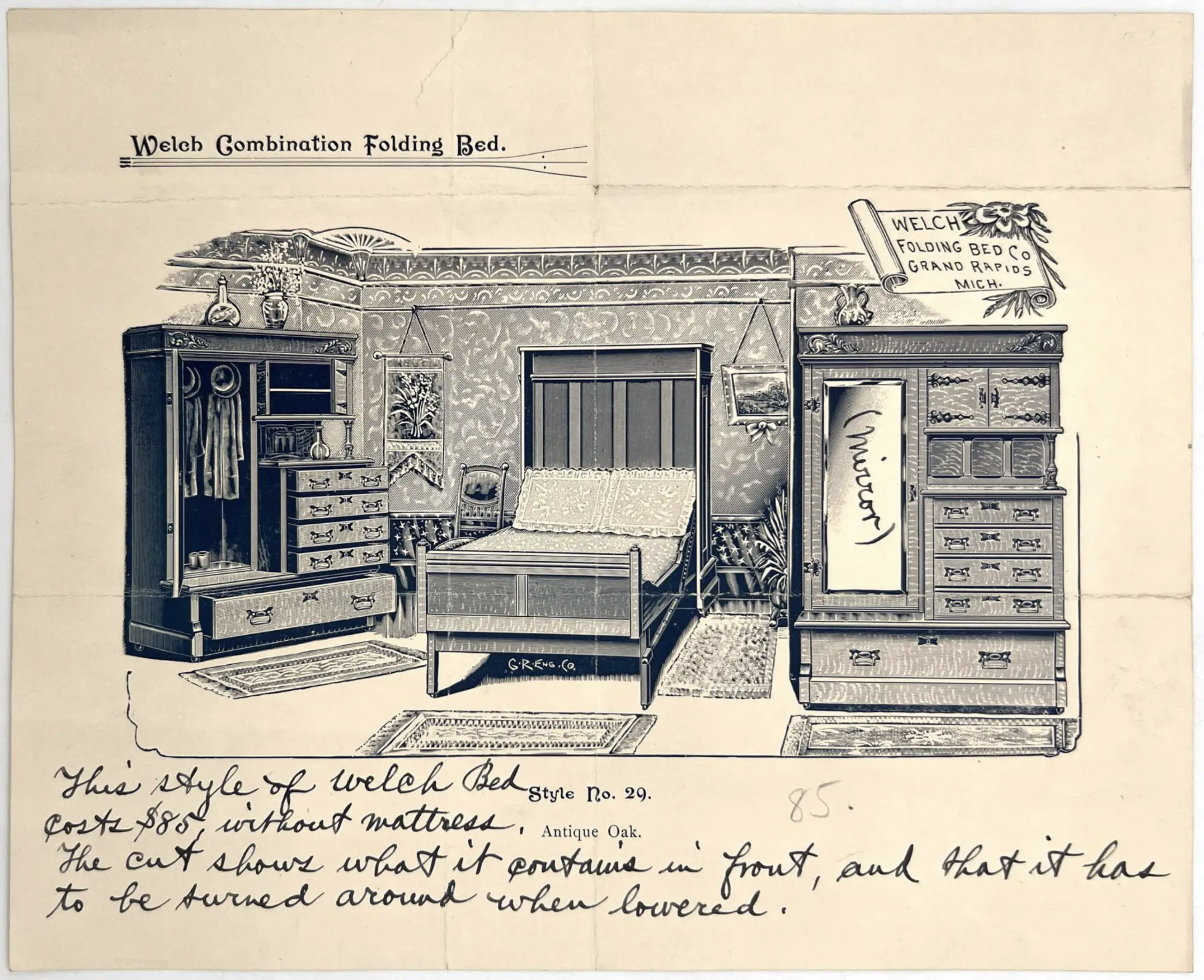
Welch Folding Bed Company product flyer handwritten description reads: "This style of Welch Bed costs $85, without mattress. The cut shows what it contains in front, and that it has to be turned around when lowered."--courtesy of Eclectibles Sheryl Jaeger & Ralph Gallo
William Sylvester Earle
Born in New York City in 1844, W.S. Earle made his way west where he wed Ella A. Pierce in 1868 at Grand Rapids, Michigan. In the 1870 directory, he was in business with his brother, James Edward Earle, selling "furnishing goods" and, according to the federal census of the same year, was also a "hoop skirt manufacturer" on Canal Street. James moved to Kansas and prior to his partnership with Lyman Welch, William had been appointed as Grand Rapids' post office superintendent.
"The Welch Folding Bed is the invention of the senior member of the firm," Robert H. Baker wrote in his 1889 book, The City of Grand Rapids Manufacturing Advantages and Commercial Importance. "The manufactory of the firm is located at Sparta, Kent county, fourteen miles from Grand Rapids... Mr. Welch is a practical artisan and has entire charge and supervision of the factory at Sparta, while Mr. Earle presides over the commodious salesrooms and office in this city, attending to financial and commercial details of the business, which is entirely of a wholesale order. A notable order recently filled from the establishment was in the furnishing of a number of the Welch beds for Vice-President Morton's Washington residence." Levi Parsons Morton of Vermont served between 1889 and 1893 as President Benjamin Harrison's Vice-President.
January 1891 found Mr. Earle traveling to Europe on behalf of the Welch Folding Bed Company. His efforts placed their products into the international marketplace. In December 1895, the Earles spent winter in California before they decided to relocate the following June and by 1800 were established at San Diego where William began an import-export business he operated briefly before retirement.
Local banker and superintendent of the factory, Manly Burtch, bought out A.K. Barnum's interests in 1899 which amounted to one-quarter of the stock in the folding bed company for $37,500.
"The company operate(s) probably the largest factory in the world devoted exclusively to the production of this line of furniture," Mr. Goss wrote about the Welch Folding Bed Company in his 1906 History of Grand Rapids Industries. "The samples are artistically designed and well constructed. Warerooms are maintained throughout the year in Grand Rapids, where buyers always find an intact line of the company's wares. L.W. Welch and Manly W. Burtch are the sole owners of the business. Mr. Welch is the president, Mr. Burtch the vice-president and superintendent of the factory."
Manly W. Burtch
Brantford, Ontario, Canada, was the birthplace of Manly, the youngest son of a carpenter--Hiram & Annis (Rogers) Burtch. During the 1860s, Hiram brought his family to Alpine township, Kent county, Michigan where, as pioneer settlers, they established a farm just south of Nine Mile Road on the east side of Peach Ridge. The 1870 Federal Census included their children: Albert, Wallace, Josephine (future wife of Nels Shaw), Jane, Manly, and Jessie. Following in the occupation of their father, Manly and Wallace, known as the "Burtch Bros" listed their carpentry services in the 1891 Michigan State Gazetteer. Both brothers took an interest in local civic affairs and organizations.
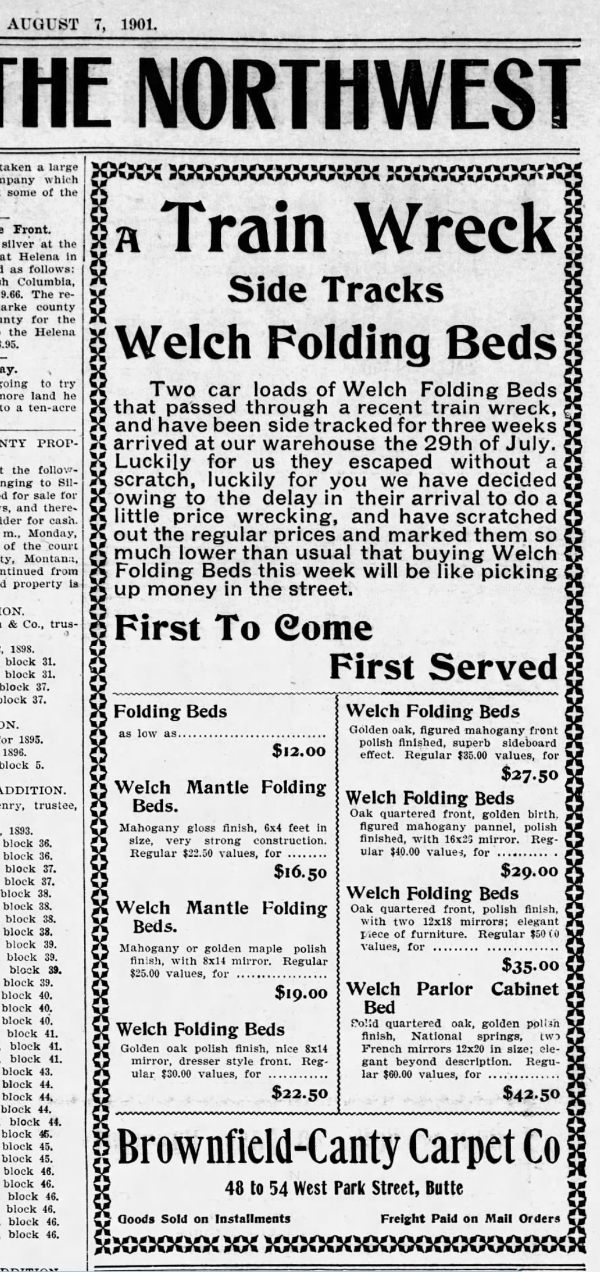
Welch Folding Bed Train Wreck ad--The Butte Daily Post (7 Aug 1901)
Wedding bells rang in 1883 when Manly and Mary Emily tied the knot. She was the daughter of German immigrants, Frederick & Catherine (Suskhart) Greiner, who farmed at Wright in Ottawa county. The Burtches had two daughters: Eva Annis and Mae Aletha. The Burtch sisters married Loomis brothers Clarence and Charles Alden, respectively, sons of Sparta merchant, Charles Loomis.
As Welch Folding Bed grew, Manly was a natural fit when he joined the company and quickly stepped into the role of superintendent where he managed foremen from the various departments. "I worked at the cabinet work about two years, and then, I think, I was promoted to foremanship and I worked at that--well, up to 1890, and from that time on I was superintendent, and in 1893 I bought stock in this company. I was superintendent up to 1900... and in 1900 I bought stock and became a member of the firm," Mr. Burtch testified in 1917. "After I bought stock I was vice-president of the company and director." In all, he was associated with the company for a total of twenty-seven and a half years.
In addition to his partnership and involvement in the Welch Folding Bed Company, Manly was among the first board of directors of the Sparta State Bank and served in that capacity for 39 years. He was elected vice-president then president, a role he held for over a dozen years.
A wildly successful sales campaign was promoted in Montana. The bold headline garnered attention in The Butte Daily Post on August 7, 1901: "A Train Wreck Side Tracks Welch Folding Beds Two car loads of Welch Folding Beds that passed through a recent train wreck, and have been side tracked for three weeks arrived at our warehouse the 29th of July. Luckily for us they escaped without a scratch, luckily for you we have decided owing to the delay in their arrival to do a little price wrecking, and have scratched out the regular prices and marked them so much lower than usual that buying Welch Folding Beds this week will be like picking up money in the street." Prices for the eight models shipped to Montana ranged from as low as $12.00 to $42.50 for an elegant one in solid quartered oak with two French mirrors.
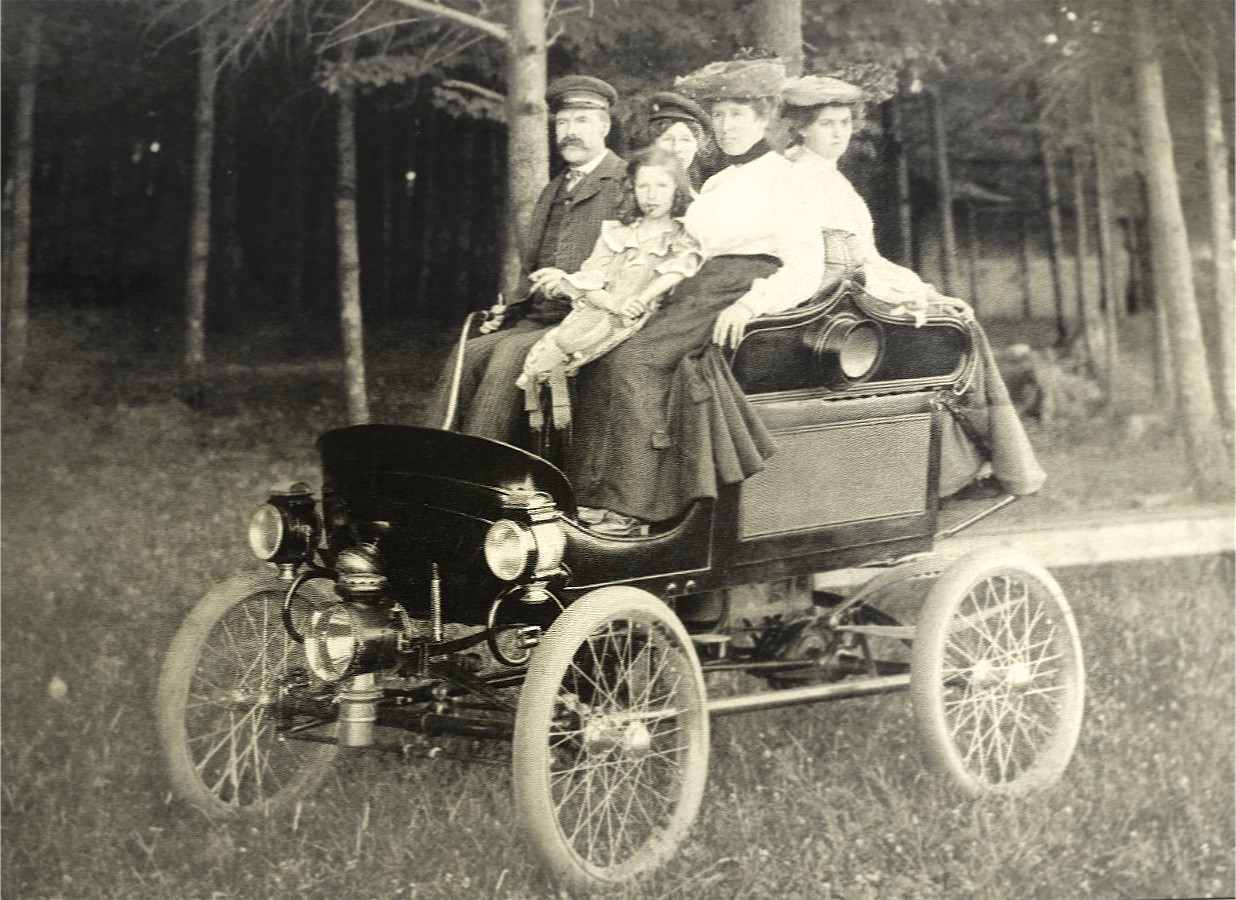
Manly & Mary (Greiner) Burtch with daughters: Mae (6), Eva (15), and possibly hired girl Ellen Olson in their Toledo Steam Runabout (1902)--STHC photo
Burtch was the first purchaser of a Toledo Steam Runabout in Sparta. Perhaps the very first auto of any make. On May 9th, 1902, the Sentinel Leader headline read: "AUTOMOBILE FOR SPARTA--Manly W. Burtch owns a Modern Steam Machine --Manly W. Burtch, vice-president of the Welch Folding Bed Co. has purchased an automobile of the most modern design. It is a steam machine, and Mr. Burtch expects to see all the surrounding country this summer. He is a man who believes in having a good time and is always looking for the latest inventions that tend to make his life more enjoyable." It was expected that before long "several would be humming along the streets of Sparta," as other business men have the "automobile fever" and "roads in this locality are good enough most of the year to accommodate these modern vehicles." Being "past the experimental stage", prices started at $650 and it could travel as fast as 25 miles per hour, "though for ordinary use this speed is not necessary."
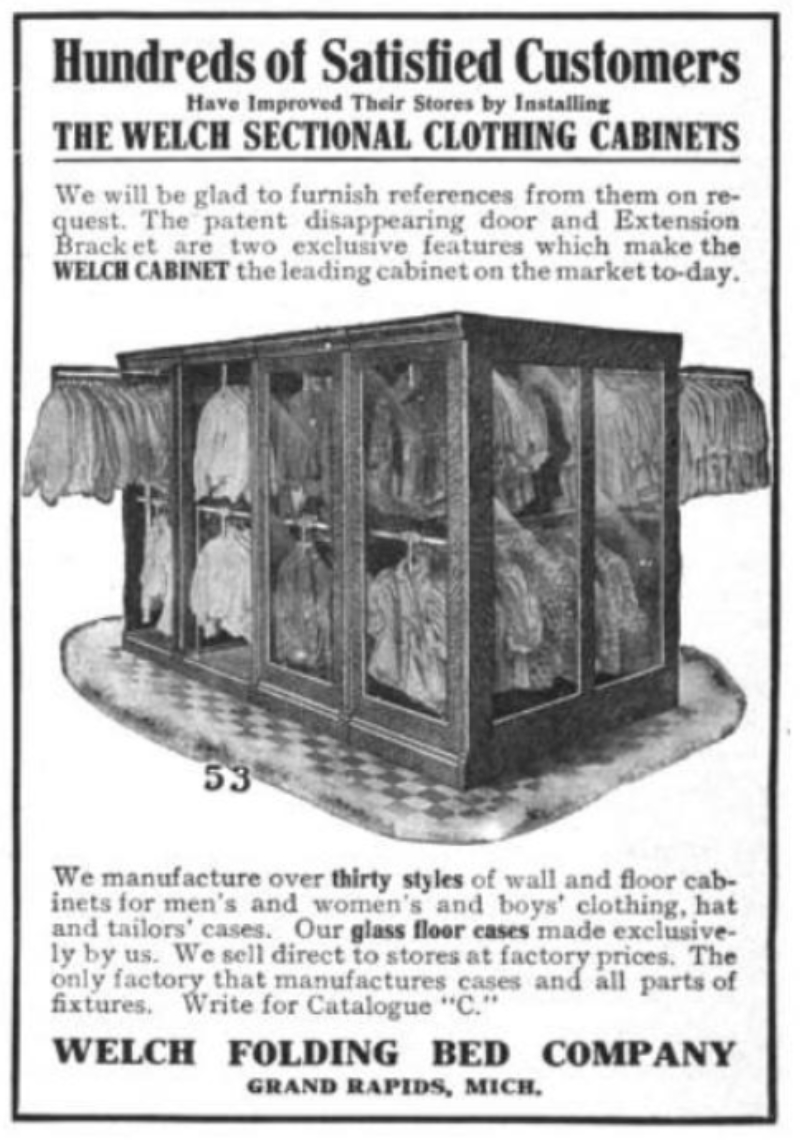
An example of Welch's patented store fixtures--Merchants Record and Show Window (1908)
Alarming headlines appeared just four days later in The Grand Rapids Press that proclaimed: "AUTO BOILER EXPLODED.--Manly W. Burtch of Welch Folding Bed Company Has Unpleasant Experience. Sparta, Mich., May 13.--Manly W. Burtch, vice president of the Welch Folding Bed company, was the victim of an automobile accident yesterday. While traveling in the country near Gooding in his horseless carriage the boiler exploded, doing considerable damage. The occupants of the carriage were forced to walk back to town, four miles, over the Grand Trunk road in theatrical fashion."
Sixty-five patterns of the Welch combination folding bed made from a variety of woods were available by 1903 in prices to fit most budgets. Demand outpaced the available local lumber supply and in 1905 the company was purchasing and shipping in choice oak lumber from Indiana.
By 1906, Sparta village relied on the water system owned by Welch Folding Bed Company and Manly Burtch, who was also superintendent of the water works. It consisted of a "tank of 3,000 gallons capacity and a cast-iron pipe distributing system of 1,200 feet of 7-inch, 1,880 feet of 6-inch, and 5,280 feet of 4-inch mains," as detailed in Flowing wells and Municipal Water Supplies by Frank Leverett. "The supply is obtained from Sparta Creek, and a fire pressure of 75 pounds is carried."
Worldwide success increased when, in 1907 "...Welch Folding Bed Company, which has a plant at Sparta, recently received orders for beds to be shipped to Alexandria, Egypt, and to Honolulu," per The Furniture Journal.
Soon to follow, it was rebranded the Welch Manufacturing Company as there was less demand for folding beds and they increased focus on sectional bookcases along with the display case and store fixtures market. New patented product lines were in demand which would eclipse their folding beds and lead to a change of direction.
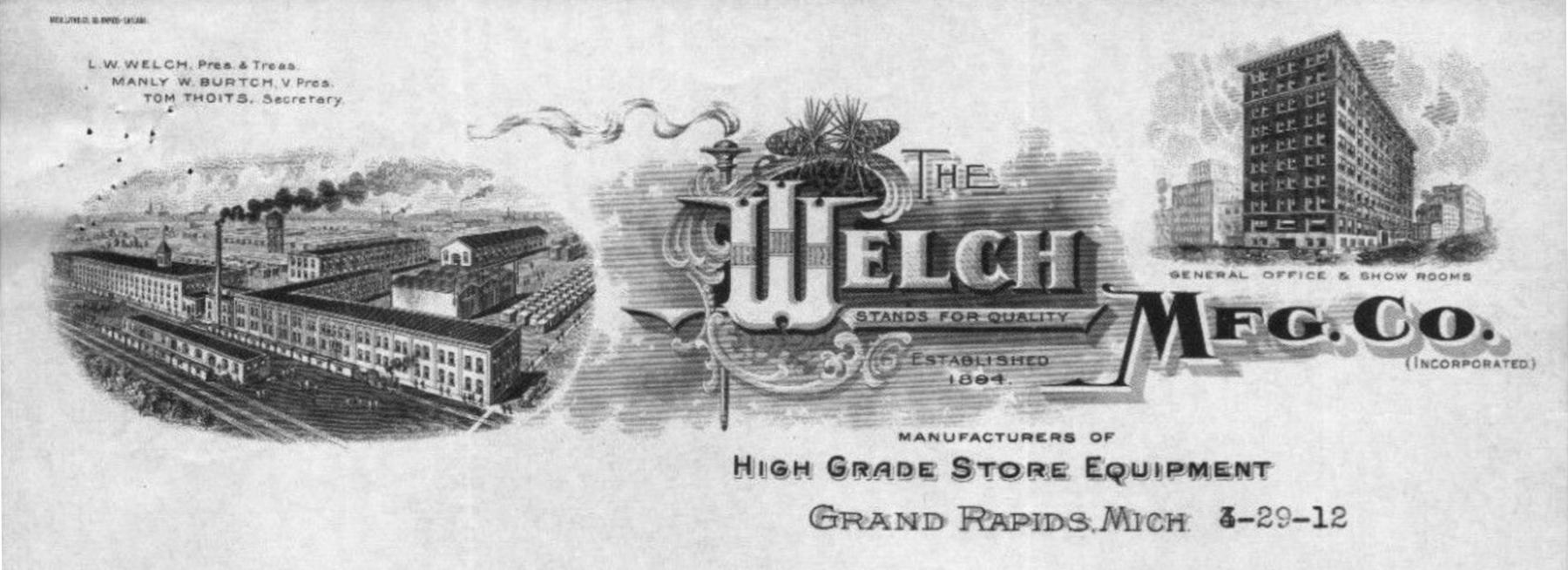
Welch Manufacturing Company graphic with Sparta plant dated 29 Mar 1912--courtesy of Randy Kosters
The merger of Welch Manufacturing and Wilmarth Show Case Companies in 1925 cemented their world-wide presence with salesrooms and representatives in major cities across the US and in Copenhagen, London, Mexico City, Maguayez, Porto Rico, and Sydney, Australia. Later as the Grand Rapids Store Equipment Co., Sparta's factory was known as "plant No. 5". "It continued to make store fixtures until 1930, when it closed," reported The Grand Rapids Press. "Much credit is due Mr. Welch for the interest he always had in Sparta. The wages he paid enabled the employees to live here and own their homes."
Kenneth Curtis Welch
A Spartan by birth on July 14, 1891, Kenneth Curtis was the long-awaited son of Lyman & Francis (Curtis) Welch. The next year, they moved to Grand Rapids where Ken grew to manhood and after college to become an architect, he returned. In 1915, he married his high school sweetheart, Dorothy Elizabeth Hompe of Grand Rapids, and they were blessed with three children: Kenneth Curtis Jr, Diana Lorraine, and Alexander William. The young mother was involved in a devestating car accident near Hudsonville on the first of May, 1920, when she was struck by a large touring car that swerved to avoid another then "plunged down a 14-foot embankment" severely injuring her left foot. Mrs. Welch underwent surgery but died of gangrene on the tenth.
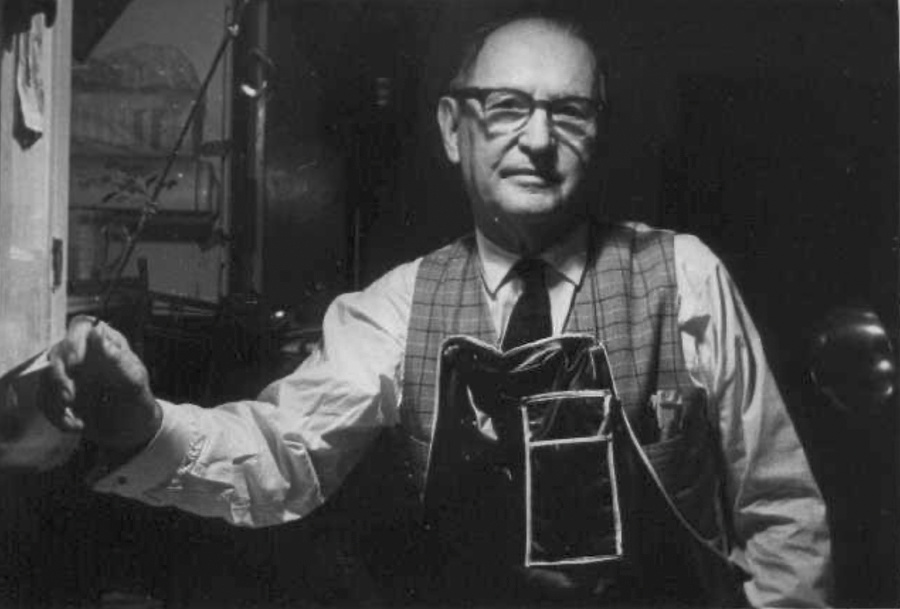
Kenneth C. Welch in the workshop--courtesy of great-grandson Warren Welch
Residential architecture during a post World War I depressed housing market set Ken on an unexpected path which would shape his future career. He utilized his design and planning skills when he went to work for his father in 1925 as Vice-President at Welch-Wilmarth. Another merger in 1928 with the Grand Rapids Store Equipment Company brought about a name change and Kenneth continued on as Vice-President of Design. The same year, he married Sparta native Lillian Althea Montgomery, the daughter of Hugh Alexander & Harriett Estelle (Hoose) Montgomery. She joined the Welch family with her sons, Russell and Philip.
Remarkably, Ken invented a door hinge and handle for refrigerator cabinets which he patented in March 1937, with assignor status granted to Gibson Electric Refrigerator Corporation of Greenville, Michigan for fourteen years.
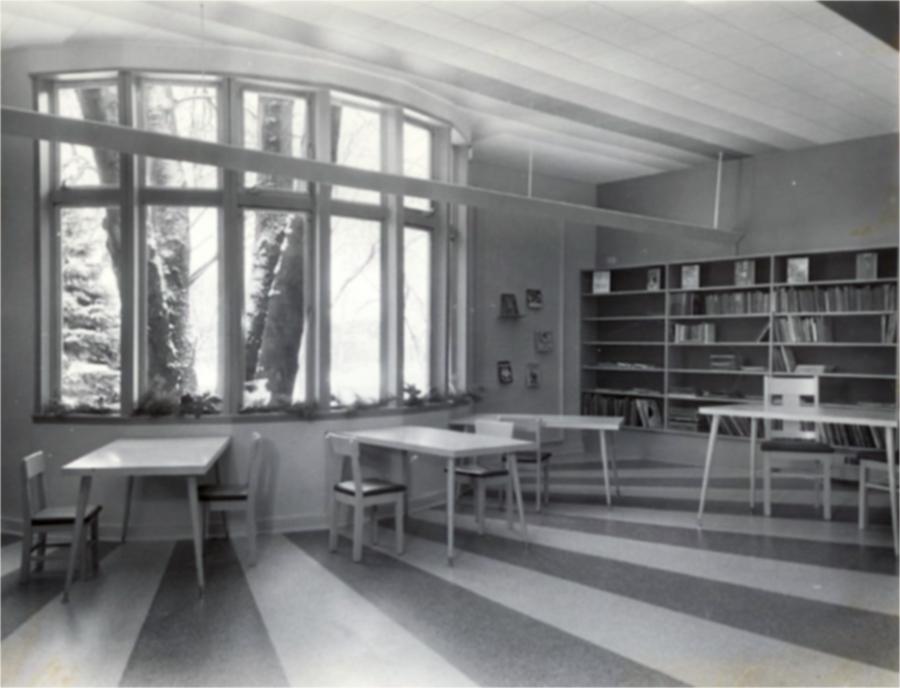
Children's library addition to the Sparta Township Carnegie Library by architect Kenneth C. Welch and interior decor by his wife, Lila A. (Montgomery) Welch--STHC Archives
Throughout the period of time he work for his father's company in the design of store fixtures, Kenneth also established his own architectural firm where his interests shifted into commercial, public buildings, and planning which he pursued full time from 1952 onward. Experience gained in creating functional retail sales environments shaped his interests. He rose to national--and international--prominence for his work in the design of shopping centers including a project in Paris, France.
Sparta always held a special place in Kenneth's heart. When the Mrs. E. Phil Bradstrum Children's Room was added on to the Carnegie Library in 1960, Kenneth was the architect and his wife, Lila, took on the role of decorator. The project was built by Ralph Taylor and Son of Sparta. "Ground was broken for the addition in September," according to the Sentinel-Leader. "He designed the room around two maple trees planted years ago by Mr. and Mrs. O.E. Balyeat. The engineering of the children's room was more complex than usual because it leans out over a steel beam resting on two piers in order to preserve the roots of the old maples which extend up to the edge of the original building. In addition to the services given by Mr. Welch, Mrs. Welch decorated the room. The room was built at a total cost of $6,854.88 by Ralph Taylor and Son, Contractors, Dick Siegel, who put in the heating, and Stanley Helmer of Stan's Electric Service who did the electrical work."
Dedication ceremony was held on December 16, 1960--and ever since that day it has had a lasting impact on the community. Entering from the austere historic portion of the building into the bright mid-century modern library with its inward curved windows focal point was magical. From the cheery orange and white sunshine ray pattern on the floor to the walls of natural maple bookcases and simple furnishings, it transported children into a world of imagination. The genius of a gifted architect's vision has inspired generations of local children to learn and love to read.
Sparta Coach
& Body Company
Formerly the Welch Folding Bed Company, the massive three story brick factory parallel to the railroad had been empty for several years when a proposal to revive it arose. The first public inkling of something in the works was announced in a front page article, SPARTA'S NEW TRAILER INDUSTRY TO EMPLOY LOCAL LABOR: Mass Production, Plus Design, Facilities and Sales Organization, Assures Success, which appeared in the August 30, 1934, issue of The Sentinel-Leader. The information was attributed to an "interview with J.G. McKenna, chief mechanical engineer of Sparta's contemplated trailer industry."
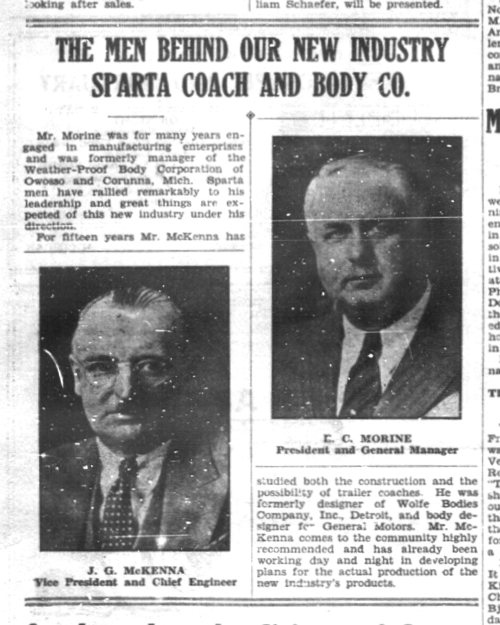
J.G. McKenna and E.C. Moraine--from The Sentinel-Leader (8 Nov 1934)
According to the United States Chamber of Commerce, popularity of trailers boomed during "the depression years of 1931-1933" as evidenced be a significant increase in their registration numbers, even as the numbers of car and truck registrations sharply declined from 30 to 23 million vehicles. Did people who lost their homes and jobs live in trailers? Quite likely.
"Mr McKenna first became interested in trailers in 1919 during a visit in England where he had been sent by his company to study European body designs. Before returning to the states, he purchased one of the European built caravans from a company which has been in existence close to 400 years. Their product, he claims, has always been closely related to the present day auto trailer, for it is this firm that has always built the old horse drawn gypsy wagon. Mr McKenna further states that this company has been profitably engaged in the same business for 400 years."
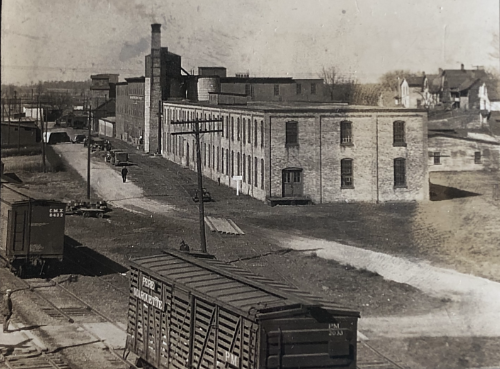
Sparta Coach and Body Company "Weatherproof factory", formerly Welch Folding Beds--series of photos of the factory and trailer coaches are courtesy of Faye Ann Bristol & Loretta Baughan
The news item went on to discuss his vision. "The market has developed to a point where it will justify putting these coaches into mass production. With the proper design, facilities and a well directed sales organization the success of such an organization is practically assured."
Most companies in the business of building trailers were very small and lacked adequate manufacturing facilities, as well as personnel. McKenna believed mass production, design, and the ability to ship to "key distribution points in knock-down form" would amount to a significant reduction in transportation costs, possibly as much as a 90% savings. All parts would be interchangeable with components not only for use on their own product, but also be available even to the do-it-yourself customer to use for his own design.
When asked how many local men may be hired, he suggested the figure to be at 50 over the first year. They would be local residents, provided there were enough men capable of doing the work, otherwise hiring outside of the community would be required.
Five weeks later on October 4th, the news read: SPARTA BOOSTERS LAUNCH TRAILER FIRM New Corporation will Occupy Welch Plant for Mass Production of Trailers, Automotive Parts--Sparta Foundry Co Officials Solidly Behind Community's Latest Enterprise--The Sparta Coach and Body Company to be Capitalized at $125,000.00 Big headline for a big story!
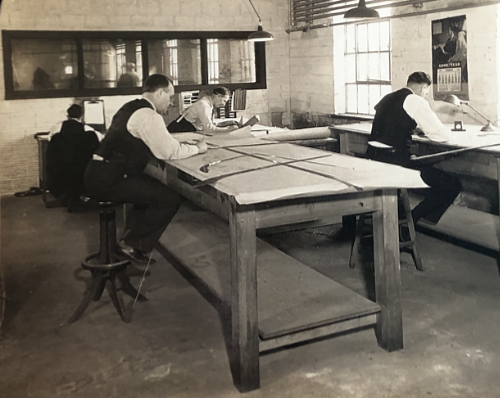
(1) The engineering department
With great enthusiasm and high hopes for a successful venture, D.W. Atkinson was voted chairman of the board. Eight additional board directors were also named: A.A. Johnson, T.E. McFall, I.E. McGowan, Harold G Vaughan, "secretary treasurer" Erastus W Smith, Forrest Field, "president" E.C. Morine, and "vice president" J.G. McKenna. All of whom were among Sparta's movers-and-shakers, with the exceptions of Morine and McKenna, who each brought a considerable amount of industry experience to the table in their own right.
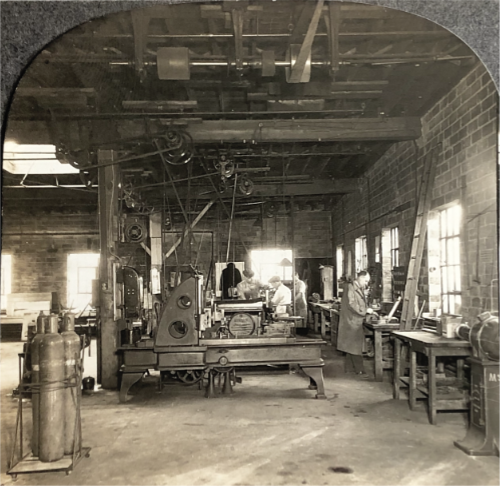
(2) Portion of the Sparta Coach and Body Co machine shop and tool room
Besides a seat on the board and the vice president title, J.G. McKenna would oversee both engineering and sales. "He has been closely identified with the trailer industry in this country since its conception. He was vice president of the Wolfe Body Company of Detroit and the designer of the Silver Dome line of coaches." Early on, Wolfe built truck bodies for Ford and Chevrolet. Wolfe began manufacturing travel trailers in 1932 and swiftly became the second largest in the industry.
Edwin Clifford Morine was a Nova Scotian, who in 1928, resided at Owosso, Michigan, where he was the founder and general manager of the Weatherproof Body Corp at Corunna. "This company in its heyday was the largest independent manufacturer of auto body parts in the state and employed over 800 men." Weatherproof was also well-known for their busses.
Daniel Webster Atkinson
Days later, on October 11th, the fledgling company lost its newly elected chairman of the board, Daniel Webster Atkinson, at the age of seventy-two. Born on December 27, 1862 at Portland in Jay County, Indiana, to Henry and Euphemia (Stratton) Atkinson, he married Emma Elizabeth Fetter in 1881. His children were Lulu "Lou" A Keller, Walter Atkinson, and Lois Pearl Burtch.
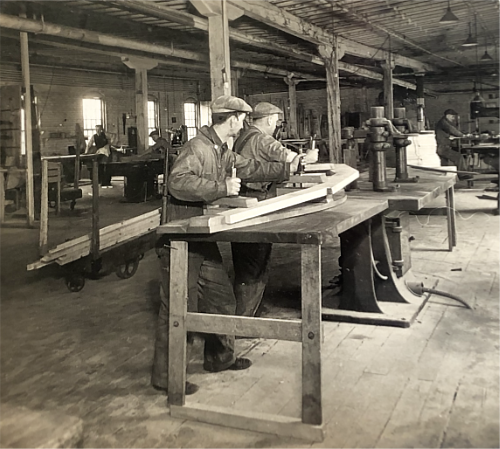
(3) Sparta men fabricating parts for the "Weatherproof Coach"
Daniel and his family arrived at Sparta prior to the enumeration of the 1900 federal census, at which time his profession was as a produce dealer. By 1910, he was involved in real estate and in 1920, Daniel was the Superintendent at Laughray Silo Company, plant No. 3 located along the railroad south of East Gardner and next to the Sparta Condensed Milk Company. Although "retired" by 1930, he was still involved with his business interests at the Piston Ring Factory, Handy Wacks, and of course, Sparta Coach and Body Company. For additional details on the Handy Wacks, see the bio of Sparta Notables member Lou Atkinson Keller.
Fellow board of directors member, Forrest Gaylor Field, was the husband of Daniel's sister, Minnie DeEtte (Atkinson) Field. Forrest was an engineer at Sparta Milling Company in 1910, became a self-employed drayman, and by 1930, a road building contractor.
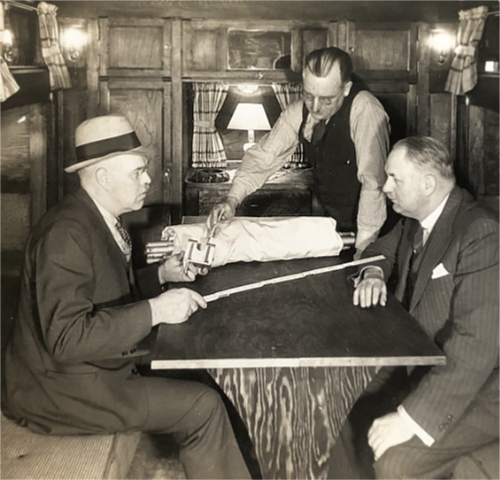
(4) from left to right: T.E. "Mac" McFall with a folding yard stick, J.G. McKenna, & E.C. Morine
In a memorial tribute entitled D.W. Atkinson, his character and last efforts were praised: "The death of D.W. Atkinson is a distinct loss to the community. For almost forty years he took an active part in the business, civic and industrial affairs of the village. He loved to work and his work was well done. He stood for decency, idealism, service, progress and character. He was never known to shrink from any service that would prove beneficial to his large circle of friends and neighbors."
"D.W. Atkinson was a fighter! All through the more than three score and ten years of a very busy life, he never missed the opportunity of adding a step to his accomplishments. He believed in himself and no matter how many discouragements, disappointments and handicaps may have piled upon his efforts to do good, he kept on fighting. He was never known to surrender to negative mental attitudes."
"At the age of 72, he entered upon the threshold of the crowning effort of his varied contributions to the community, through the organization of the Sparta Coach and Body Company, of which he was elected to serve as chairman of the board. With a strong, vigorous and clear mind, he personally directed the building up of this new industry and it was largely through his indomitable will and conscientious work that the idea of such an organization became a reality."--H.J. Kurtz (18 Oct 1934)
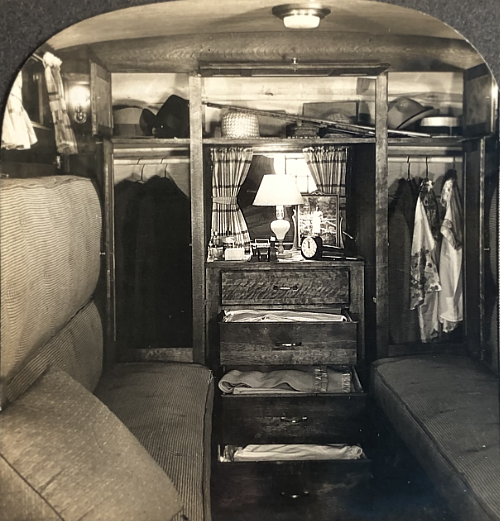
(5) Storage in rear section of the coach with the seat cushions which also serve as the bed mattress
In spite of the loss, progress continued--just as D.W. Atkinson would have wanted.
By the first of November, a major hurdle was cleared: SPARTA COACH AND BODY CO. FINANCING IS LAUNCHED--Securities Exchange Corporation Undertakes Financing of Our New Industry and the stock provided needed start-up funding. Common stock would sell for $1 a share while the preferred stock cost $1.10 and was expected to pay up to 7% in dividends. In addition to the trailers, negotiations were "well underway for a considerable amount of automobile body woodwork with several body manufacturers and it is anticipated that the company will be in production on this phase of their business within the next two or three weeks and it is believed that the company should show a substantial profit from this phase of the business alone."
The Sentinel-Leader went on to say, "The plant and equipment have been purchased for a ridiculously low price." In reference to the participation of T.E. McFall, but without directly naming him, his involvement in marketing stock in 1929 for the Sparta Foundry Company was noted as "extremely successful" and the start-up capital raised for the Mid-West Refineries, Inc, which had tripled in value over the last nine months.
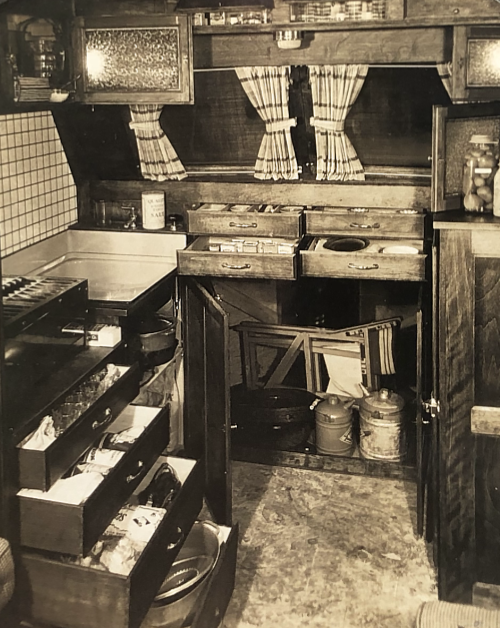
(6) Generous amount of storage in the front galley of the coach
By December 6th, a sales staff of twenty-one salesmen had been hired. E.C. Morine and director, Harold G Vaughan, brought their salesmen to a meeting of the Securities Exchange Corporation held at the prestigious Peninsular Club in Grand Rapids. Both men made well-received presentations and it was stated the "entire allotment of shares authorized for sale at this time will soon be over-subscribed," the local paper reported.
As promised, Sparta Coach and Body Company was quickly up and fully operational at what was initially called the "Weatherproof Factory". The facility boasted of an impressive "120,000 feet of manufacturing floor space, equipped with the most modern machine tools available for this class of manufacture," according to the detailed descriptions printed on the reverse of a set of promotional stereoscopic viewer cards dated from March of 1935.
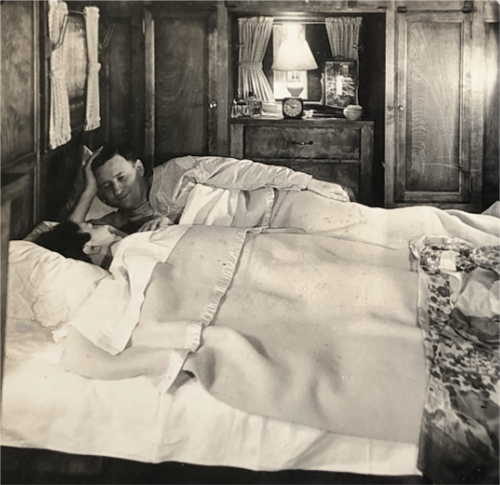
(7) Sparta Coach and Body director, Harold G. Vaughan and his wife, Vivian, enjoy the spacious comfort of the full double-bed in the basic model
The engineering department image (1) depicted J.G. McKenna seated at the drafting desk in the foreground "Where every detail is thoroughly worked out before going into practice".
The photo (2) described as a "corner of the machine shop and tool room where special tools and parts are fabricated" (and at the top of this page) provides a fascinating glimpse of the men at work, a view of the inside the factory, and its belt drive system. The factory was equipped with its own 350 kilowatt power house.
Men dressed in warm coveralls and caps (3) were at work on the factory floor as they utilized special forms "on the machines for fabricating each individual part. This method insures precision and accurate duplication". Once finished, parts were transferred to a storage room where they remained until needed for the assembly line.
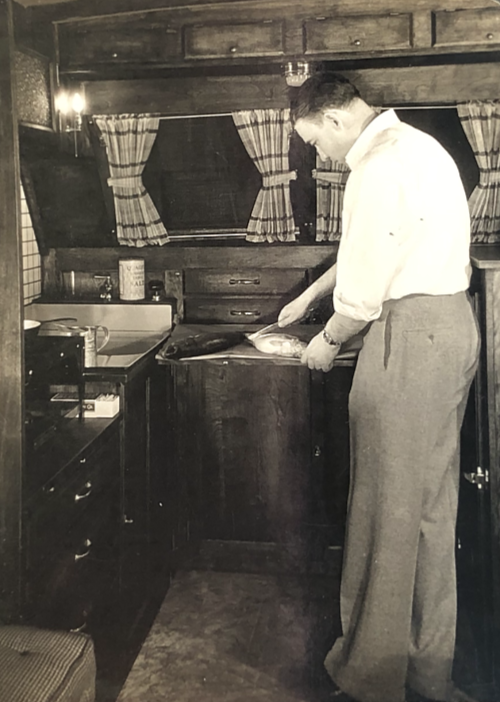
(8) The kitchen galley designed with meal prep in mind
A photograph inside a "Weatherproof Coach" manufactured at Sparta (4), "T.E. McFall, Chairman of the Board; J.G. McKenna, Vice-President and and E.C. Morine, President of the company shown in one of the coaches making a study of the new patented auxiliary beds. All of the parts for two beds are seen in the package on the table before them. These two auxiliary beds weigh approximately 20 pounds, and are so small that they may be stored in one of the drawers or most any compartment in the Coach." The company applied for and received several patents.
How intriguing and what an ingenious idea! From the size and appearance of the bundle displayed on the table, it seems these rods and fabric became a cot styled bed when put together, similar to an army cot, but constructed from lighter materials. The compact auxiliary beds were most likely best suited for children or a small adult, which was sure to increase the trailer's appeal for use on family vacations.
The same area of the coach where the three gentlemen were seated in an earlier image, now with the table dismantled (5) provided "a view of the rear of the coach in a convertible model, showing the divan beds folded as they would be in travel; with the doors to the wardrobes and other compartments open to give you an idea of the vast amount of storage space available."
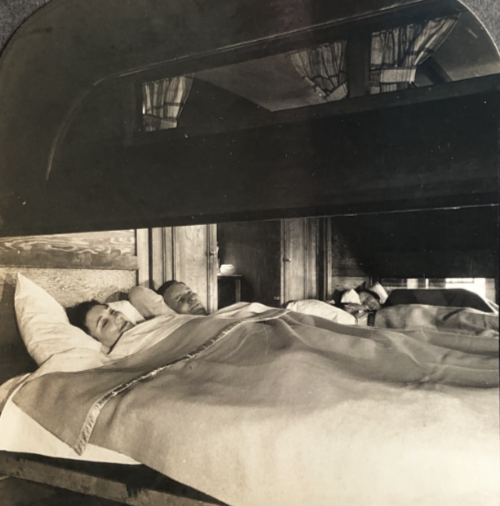
(9) Convertible model beds on either side of the entrance to the galley
Quite a clever, well conceived design with closets to hang clothes wrinkle free, cabinets, and a bank of drawers to provide the travelers with ample room.
The efficient modern galley (6) was located in the forward section of the coach. It was well-lit by both windows and electrical lighting. "This view is identical in both the standard and the convertible Nomad models. You will note that all compartments are full size and provide even more room for the purpose than found in the average home." Perhaps a bit of an overstatement, but when one considers the compact nature of the travel coach, they did a great job of providing functional storage.
How interesting to see a roasting pan in the galley's bottom drawer!
Sleeping accommodations (7) were first rate. "Showing the full double bed arrangement in the standard two-passenger job. This model may also be equipped with the auxiliary beds... thereby providing sleeping accommodations for two more people. This model differs from the convertible only in sleeping arrangement."
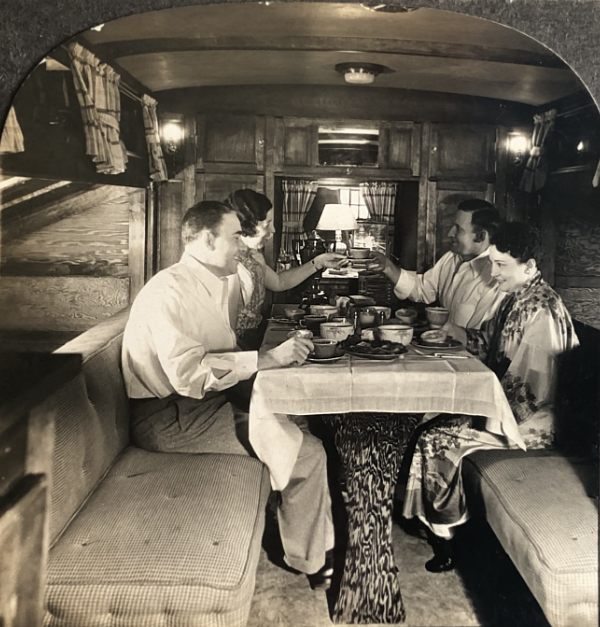
(10) Enjoying a hearty breakfast in style!
"The view of the galley shows the liberal sized work table extended," which slid out from the front portion of the cabinetry, "and the real beauty and neat arrangement of this compartment," as the man (8) who prepared a fish demonstrated.
On the larger coach model, (9) there were side sections which expanded to accommodate the two double-bed configuration that enabled the coach to sleep four adults. Again, with the auxiliary beds, it was considered a six-sleeper. "A view looking across the extended bed compartments in the convertible model to give a further idea of the room provided in this convertible job."
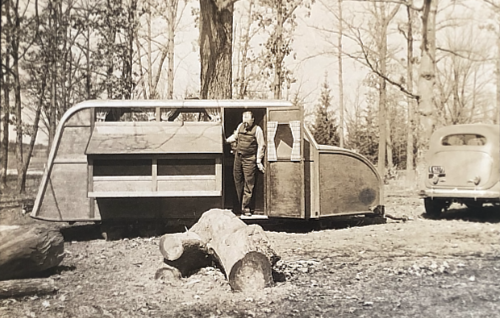
(11) Mr McKenna exits the larger convertible coach
Four adults seated at the table in a photo (10) that "shows a breakfast scene. Here we see a breakfast nook as liberal in size, and beautiful in appointments as those found in the modern home." Behind the seating, a portion of the expanded areas for the full sized beds are visible. The couples in these photos were likely company board of director members along with their wives. In the foreground were Harold and Vivian Vaughan. Do you recognize the other couple?
The Weatherproof Coach (11) was the only trailer to feature a full height door on the side. It also included "hydraulically operated jacks to bring the coach to a level position even on uneven ground." From its aerodynamic nose to interior fine craftsman finishes, it was innovative.
"With a Weatherproof Coach you go where you choose, regardless of grades and road conditions. In fact, this coach can be taken up grades, through sand, mud, etc., where the automobile pulling it could not go by itself. As anyone knows, a car's pulling power is limited to its traction. When the wheels start slipping, that is its limit. Likewise the limit of its brake function is governed by its skidding. The extra weight of approximately 500 pounds on the rear wheels of the car increase the traction in a greater proportion than the extra power needed to pull the car. The same relation exists in the braking function of the car brakes, inasmuch a the extra weight retards skidding."
Sparta Coach and Body Company certainly built a quality product with potential for a bright future. But all was not smooth sailing.
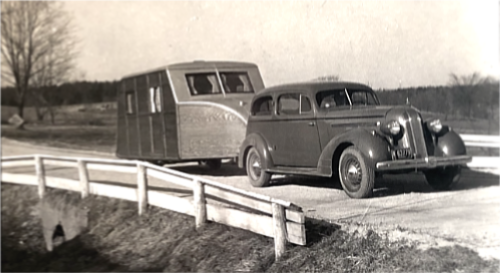
"Weatherproof Coaches conform to the lines of the modern automobile and provide an appearance not equalled in any other coach on the market."
With so many powerful men and big personalities involved, it wasn't long before differences of opinion bubbled into discord. The friction and conflict was short lived--it was resolved by the close of May 1935 as the local paper reported:
- T.E. McFall Heads Management of Sparta Coach and Body Co.
TWO PROMOTERS RESIGN FOR GOOD OF CORPORATION; AL BJORK BECOMES DIRECTOR
T.E. McFall, Sparta's industrial magnate, has assumed the managerial duties of the Sparta Coach and Body Co., according to an announcement issued this week by the officers and directors of the company.
Mr McFall is chairman of the board of directors of the company, president of Sparta Foundry Co., and vice-president of Mid-West Refining Co.
The change was necessitated when resignations of E.C. Morine, general manager and J.G. McKenna, chief engineer of the organization, were accepted by the directors at a recent meeting, for the good of the company.
While Mr McKenna is no longer associated with the organization, Mr Morine still retains his position as president and director of the company.
Under Mr McFall's direction the company anticipates a number of changes which will effect the design of future "Weatherproof" Coaches and speed up production.
Al Bjork has been appointed a director of the company to fill the vacancy created through Mr McKenna's resignation.
A report recently issued by the company to the shareholders listed the factory buildings and all machinery as paid in full and many other satisfactory results attained for the small amount of money expended to date.
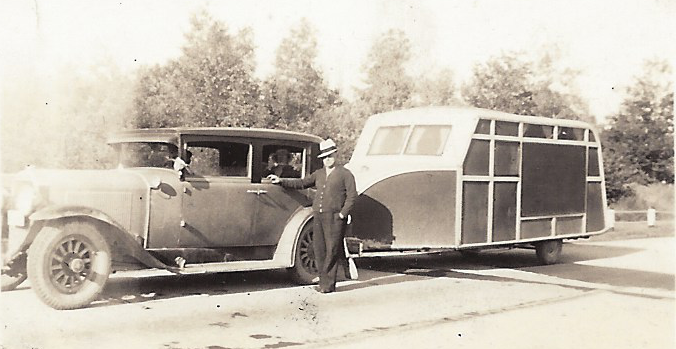
Ready for the road, Charlie Badgerow posed with his Sparta-made Weatherproof coach rig, which slept six
The company was incorporated a few months ago largely through the indomitable will, courage and foresight of the late D.W. Atkinson and I.E. McGowan and under its present management is destined to become one of the major "Trailer-Coach" industries of the country.
One of the early purchasers of a "Weatherproof" Coach, which slept six, was Sparta businessman owner of Badgerow Store and Gas Station, Charlie Badgerow. Always interested in new inventions and gadgets, he bought what he referred to as "McFall's trailer" to use on trips to visit family located around the state and to take his five grandsons--Charles, Paul, Jim, Cart, and Gordon, or other family members, on fishing and camping excursions.
I have no doubt that Charlie got it at a very good price. Mr. McFall also gave him the set of stereoscopic cards.
Thwaites X-Ray Machine
It is said, "All good things must come to an end," and the Sparta Coach and Body Company was no exception. A little more than one year after the fledgling endeavor basked in the fanfare of its founding, it had arrived at the end of its journey. "An original plan conceived by the local Chamber of Commerce received a temporary set-back when the proposition to bond the village for $20,000 to purchase the Welch-Wilmarth plant for manufacturing purposes was defeated by a slim margin of five votes." T. E. McFall provided the loan in exchange for a mortgage on the plant and equipment as security, however, the company was unable to meet their financial obligations. Consequently, on April 30, 1936, the headline: TO LIQUIDATE THE SPARTA COACH AND BODY COMPANY was splashed across the front page of The Sentinel-Leader. It was announced that sealed bids for the plant, buildings, acreage, machinery, and equipment would be accepted on the first of June—with everything going to the highest bidder.
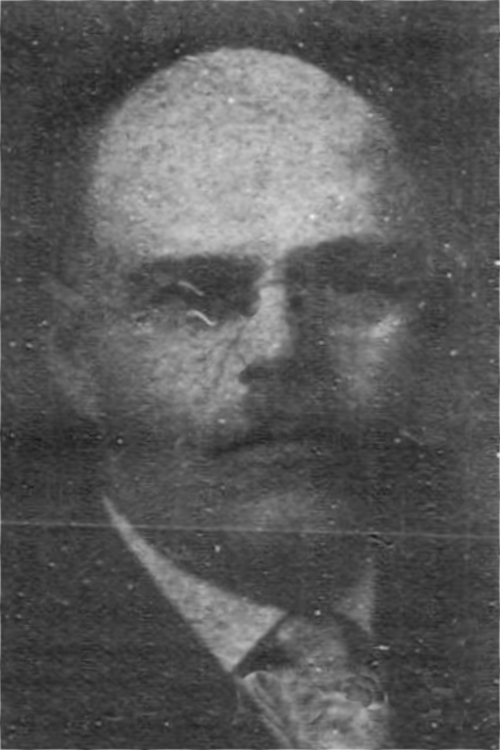
T.E. "Mac" McFall
Already, Wolverine Trailer Coach Company, operated by John R. Shooks and Forrest G. Field, along with Thwaites Ray Machine Company occupied portions of the massive manufacturing facility. T.E. "Mac" McFall was instrumental in bringing new manufacturing businesses to Sparta. His involvement included the position of vice president and manager of the Thwaites Ray Machine Company.
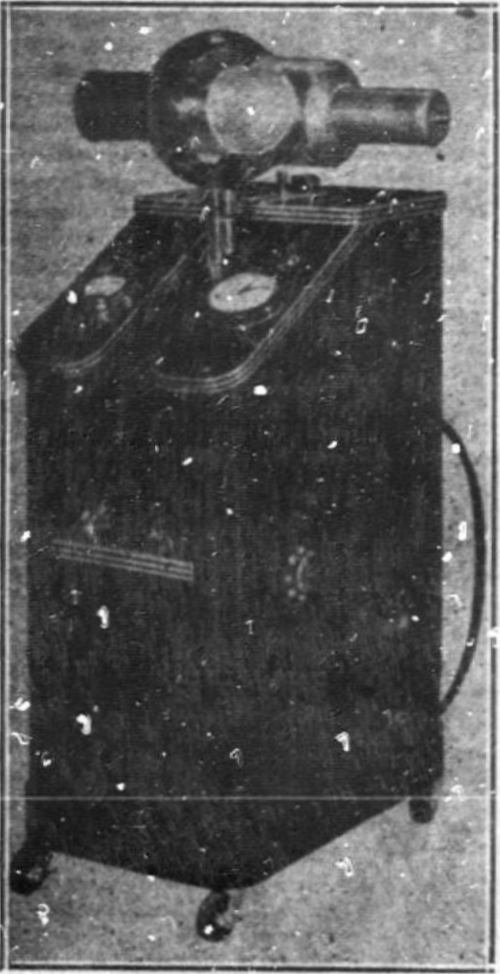
The Thwaites X-Ray machine made at Sparta
A first shipment of Sparta-made X-Ray machines was announced on June 11th, to fill orders from Ohio.
"Mr. Shooks came to Sparta in October, 1934, as office manager for the Sparta Coach and Body Company, which he later served as assistant secretary," The Sentinel-Leader wrote. "He has had many years of business experience and before coming to Sparta was associated with the Hart Mirror Plate Company of Grand Rapids. Mr. Shooks is married, has one daughter, and resides on Orchard Drive." Shortly after this appeared in print, he left Wolverine and took a position with Thwaites.
By June 18th, it was announced Forrest Field and his wife had purchased the north end of the massive industrial building and Thwaites, the south end. Before long, Handy Wacks relocated into the remaining portion until they constructed their own new facility nearby. Previously, both the Thwaites and Handy Wacks companies had operated in Grand Rapids.
Dr. William Henderson Thwaites
The future inventor was born on 4 Feb 1885 to James & Leila Irene (Henderson) Thwaites at Long Rapids, Alpena, Michigan. In 1910, the family was enumerated at Ann Arbor where William studied dentistry at the University of Michigan and then graduated the following year. In 1913, he wed Grace Murray at Grand Rapids and by the 1920 Federal Census, he had become a self-employed dentist.
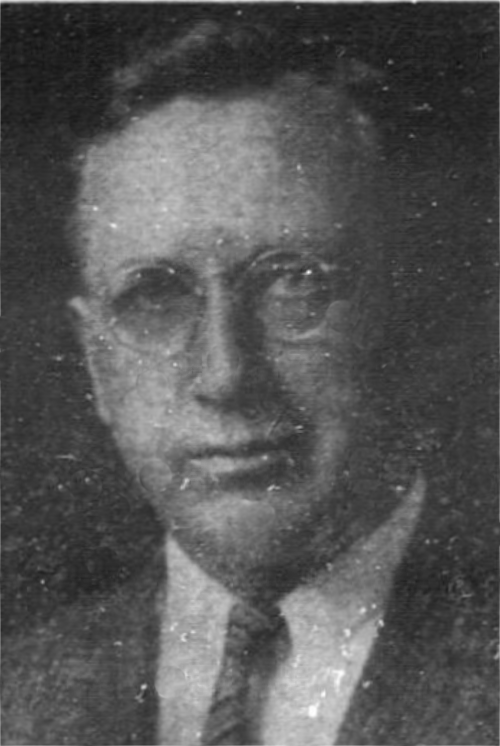
Dr. William H. Thwaites
Wilhelm Conrad Röentgen, a German mechanical engineer and physicist, discovered X-Rays on November 8, 1895, and in 1901 was subsequently awarded the first Nobel Prize in physics. Two weeks later, two Germans produced the first dental radiographs, with exposures of twenty-five and thirty minutes. It was noted some irradiated patients experienced "a loss of hair". Others soon developed improvements, such as a focus tube which lessened the exposure time to nine minutes and resulted in a clearer image.
Unaware of the dangers, it wasn't long before researchers, dentists, and their assistants began experiencing radiation burns, eye damage, poisoning, and cancer. One unfortunate victim was an assistant to Thomas Edison named Clarence Madison Daily. He developed cancer in both of his hands requiring the amputation of his arms--to no avail--and his life was claimed by the insidious disease in 1904.
Edison immediately halted his experiments with X-Rays.
That same year, a Boston dentist, William H. Rollins, spoke out on the urgent need to protect workers and patients from radiation in his published articles. Unfortunately, neither his contemporaries nor the government heeded his warnings.
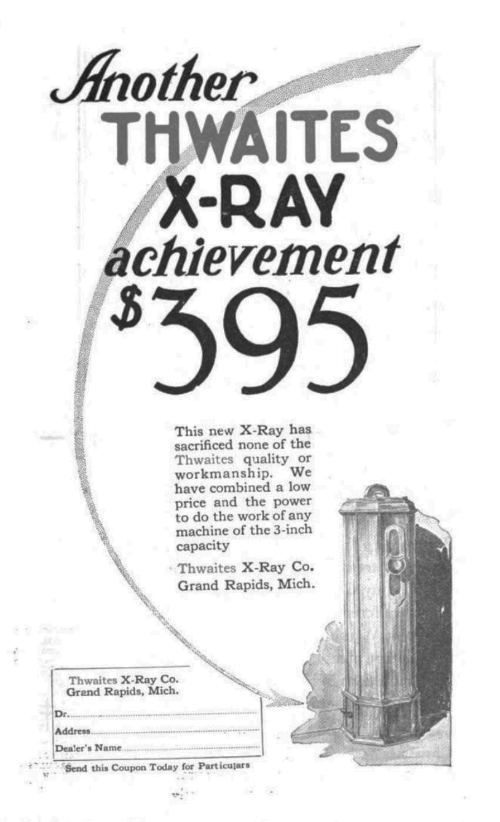
An advertisement from November 1924 for the Thwaites X-Ray machine from a trade publication, The Dental Summary: A Journal of Practical Dentistry
While he studied at the University of Michigan Dental school in 1909, Thwaites became fascinated by the field and served as assistant to Dr. Loefler, head of the X-Ray department. Throughout his career Dr. Thwaites was viewed as a pioneer in the study and use of X-Ray in dentistry. To make the machine and procedure safer was one of his driving goals. According to an article from The Dental Register: The Magazine of Dentistry in February 1923, "The safety of this outfit is obtained by eliminating the ground wire which in other machines is supposed to be a safety device. In the Thwaites, however, the elimination of the ground wire makes it safe. There is no static in the machine from the induction coil, therefore no charge of electricity seeking to ground through adjacent objects." It was claimed that neither the patient nor operator of a Thwaites unit was exposed to the "ordinary dangers accompanying X-Ray operations".
By 1925, Thwaites X-Ray Company was promoting its $800.00 units with "80,000 volts" which used a "Coolidge tube and transformer" that also had "medical capacity" use for "lung, hip, or abdominal pictures". Other models sold for as little as $395.00. Thwaites products were sold across the nation and in foreign countries.
Regrettably, business at the Sparta plant had not become as robust as hoped. Consequently, by 1938, Dr. Thwaites left the manufacturing company and focused on his dentistry practice from his home at 159 Lafayette Ave NE in Grand Rapids. Decades of work with radiation took a toll and the dentist developed cancer of the nose, for which he underwent surgery in 1944, before it spread to his neck. On the 28th of September, 1945, it claimed his life.
William Albert Young
Bert was born on May 28, 1897, the son of William A. & Ida May (Powers) Young. The event took place at Ferry in Oceana county, Michigan.
Relocated to Sparta, Bert was well-liked and his classmates elected him president of the Class of 1916. Shortly after graduation, from May 1917 until March of 1920, he served as a sergeant within the Medical Department of the US Army. On leave in May of 1918, he married Hilda Alberta, the daughter of Albert H. & Nora (Brown) Meeker of Sparta. The couple would have three children: Betty Jane, Jack Wendell, and William Albert III.
The Youngs rented a home on North Union, owned by Walter Bloomer. On December 12, 1935, they moved into the lovely Victorian Laurence Johnson house at the northwest corner of Washington and Centennial Avenue.
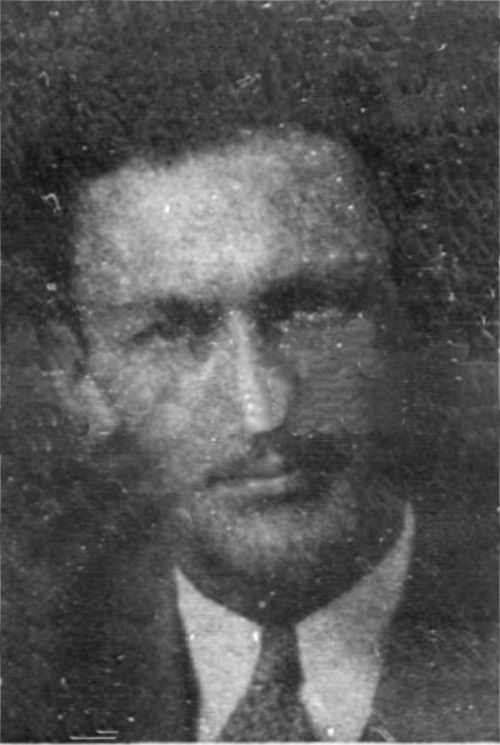
Bert Young
"Mr. Young, who is a graduate of Sparta high school and has maintained his residence here for a number of years, has recently been appointed Director of Sales for Thwaites Ray Company," The Sentinel-Leader reported on June 11, 1936. "(He) spent six years as a senior bacteriologist in the United States Public Health Service and during the past twelve years has devoted his entire time in sales promotion activities, specializing in organization and personal selling. He has also been district sales manager for several years with the West Bend Aluminum Company of Wisconsin and more recently Regional Sales Manager of the Mackey Publishing Company, Chicago."
Once the Thwaites Company dissolved, Bert returned to a sales position. In August of 1939, the family took a vacation to Montana and upon their return moved from their home on Centennial to his 87-year old father-in-law Albert Meeker's home at 131 S. Union St. to care for him. After his passing in 1942, the Young family resided at 42 Centennial Avenue. Their son, Cadet Jack W. Young, enlisted to serve during WWII as an aviator but suffered a tragic accident while training in California. (See the Veterans page for his memorial.)
Dr. Charles Sherman Miller
John Jakob & Mary (Ermer) Miller welcomed their newborn son, Charles, on 27 Oct 1895 at Putnam county, Ohio. The father died in 1899 and left his widow with five young children to raise on her own. In 1900, the family relocated to a farm at Wise township in Isabella county, Michigan. Charles became a dentist, married Mabel M. Lentz, and began his practice at Chesaning, Saginaw county by January 12, 1920, when the US census was recorded.
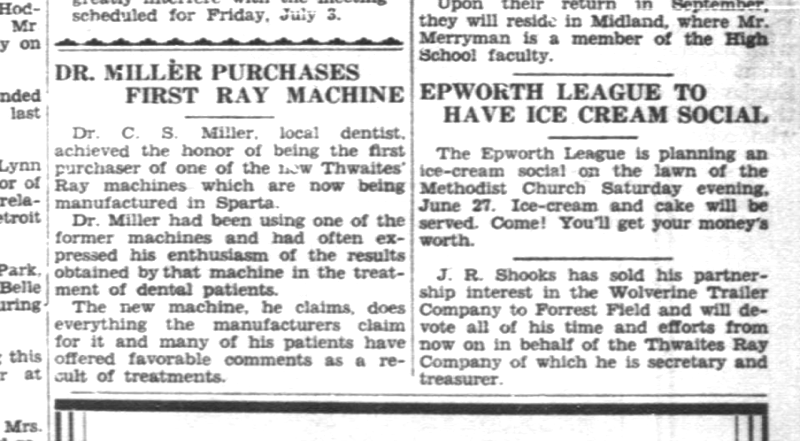
Dr. C.S. Miller's purchase of the locally made X-Ray machine
The young dentist arrived at Sparta in April of 1923 to begin a well-respected practice which would span thirty-five years. "I went to work for Dr. C.S. Miller in 1923 to 1925, a dentist, and he taught me how to make plates, gold inlays, and to do his laboratory work. I worked for him for $15 a week," my grandmother, Faye Badgerow, wrote in her memoirs about employment before her 1926 marriage to Clarence Fullmer and the establishment of her own beauty salon business at Sparta. "Later, he raised me to $20 a week."
Enthusiasm among those in the dental profession for Thwaites' X-Ray machines was high—as Sparta's own Dr Charles Miller stepped forward to announce his purchase of the first ray machine produced locally with a front page article in The Sentinel-Leader. The item published on June 25, 1936, read: "Dr. C.S. Miller, local dentist, achieved the honor of being the first purchaser of one of the new Thwaites' Ray machines which are now being manufactured in Sparta." He had previously used earlier models in his practice.
The Miller family resided at 319 S. State Street at and previous to the 1940 Federal Census. A son, Harold Charles Miller, served in the Navy during World War II, then later, in September 1958, joined his father’s Sparta dentistry practice.
Contact

Sparta Township Historical Commission headquarters at 71 North Union Street
Our History Center is conveniently located at 71 North Union Street in downtown Sparta. Please join us for coffee and lively conversation on Monday mornings. Visits to the History Center can also be scheduled by appointment, for your convenience.
We do not receive mail at the History Center, instead, please use our mailing address, which is:
attn: Sparta Township Historical Commission
Sparta Township
160 E. Division St.
Sparta MI 49345
Our complete archives are now available online for your convenience. Just click STHC PastPerfect Catalog Access and begin your research!
For other inquiries, the Sparta Township Historical Commission can be reached by phone at: (616)606-0765 or via email at the following address:
